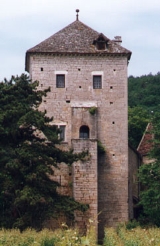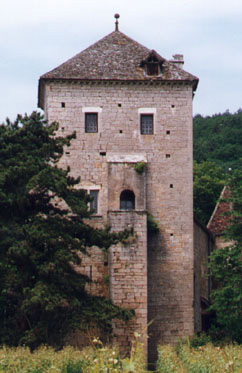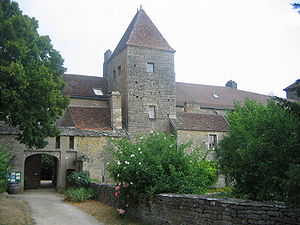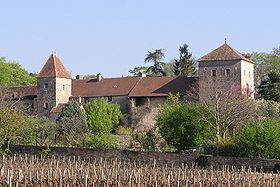
Château de Gevrey-Chambertin
Encyclopedia
The Château de Gevrey-Chambertin is located in Burgundy
, 12 km from Dijon
and 30 km from Beaune
.

, was certainly considerably revised in the second half of the 13th century, and was, during St Bernard lifetime, and even probably slightly earlier, a priory belonging to the Abbey of Cluny. Hughes, bishop of Auxerre, and his sister Maheldis, both descendants of Manasses of Vergy, a powerful leader of Burgundy in the 9th century, in 1015 and 1019 donated the "CURTIS" called Gevrey to the monastery of Cluny of which abbot was then St Odilon.
Then, Yves de Poisey and his nephew Yves de Chazan , both abbots of Cluny and born of the lords of Vergy, gave its first official appearance to the building, between 1257 and 1275 : a vast rectangle, surrounded with moats. The southwest entrance was composed of a stone bridge, and further a drawbridge
, flanked by two square towers. A big square tower
stood at the southeast corner, and at the northeast was a dovecote on top of a small "cul de lampe" tower. At the northwest, a gallery could be seen on top of a round tower. The wall with its covered way allowed to walk from a tower to the other. Plundering, wars, fires and time have all contributed to the destruction of the fortress. The only remaining parts of the original buildings are the drawbridge (considering that one of the towers and the drawbridge system are lacking), the big square tower, and the living quarters next to the drawbridge. Several remnants of the wall allow one to have an idea of what the chateau used to look like.
 Among the many works done since 1791, the date of sale of the castle as a national estate and until the end of the 19th century, the conversion of the middle floor of the square tower was probably the cause of the destruction of the exceptional tiled floor, dating from the time of St Bernard or maybe Yves de Poisey. This tiled floor, which probably already needed a mending, was not preserved as it should have been, considering its age and its artistic value. It was thrown away in what was called the "arsenal", and which is now a grass-covered terrace. Pieces of these glazed tiles, some of which intact and some broken, were found from place to place in the lime mortar of some walls, hardly buried in the immediate surroundings of the building, or found in the terrace while working on partly falling walls. Examples of these glazed tiles, some intact and some broken, were found everywhere- in the lime mortar of certain walls, buried in the immediate surroundings of the building, or found in the terrace during work made necessary by the fall of one of the walls that surrounded it.
Among the many works done since 1791, the date of sale of the castle as a national estate and until the end of the 19th century, the conversion of the middle floor of the square tower was probably the cause of the destruction of the exceptional tiled floor, dating from the time of St Bernard or maybe Yves de Poisey. This tiled floor, which probably already needed a mending, was not preserved as it should have been, considering its age and its artistic value. It was thrown away in what was called the "arsenal", and which is now a grass-covered terrace. Pieces of these glazed tiles, some of which intact and some broken, were found from place to place in the lime mortar of some walls, hardly buried in the immediate surroundings of the building, or found in the terrace while working on partly falling walls. Examples of these glazed tiles, some intact and some broken, were found everywhere- in the lime mortar of certain walls, buried in the immediate surroundings of the building, or found in the terrace during work made necessary by the fall of one of the walls that surrounded it.
The castle is the property of the Masson family since 1858, and is open for wine tasting and visits.

Bourgogne
Burgundy is one of the 27 regions of France.The name comes from the Burgundians, an ancient Germanic people who settled in the area in early Middle-age. The region of Burgundy is both larger than the old Duchy of Burgundy and smaller than the area ruled by the Dukes of Burgundy, from the modern...
, 12 km from Dijon
Dijon
Dijon is a city in eastern France, the capital of the Côte-d'Or département and of the Burgundy region.Dijon is the historical capital of the region of Burgundy. Population : 151,576 within the city limits; 250,516 for the greater Dijon area....
and 30 km from Beaune
Beaune
Beaune is the wine capital of Burgundy in the Cote d'Or department in eastern France. It is located between Paris and Geneva.Beaune is one of the key wine centers in France and the annual wine auction of the Hospices de Beaune is the primary wine auction in France...
.

History
The castle of Gevrey-ChambertinGevrey-Chambertin
Gevrey-Chambertin is a commune in the Côte-d'Or department of France in the Bourgogne region in eastern France.It lies 15 km South of Dijon. This touristic, winemaking village is situated on the Route des Grands Crus in the Côte de Nuits...
, was certainly considerably revised in the second half of the 13th century, and was, during St Bernard lifetime, and even probably slightly earlier, a priory belonging to the Abbey of Cluny. Hughes, bishop of Auxerre, and his sister Maheldis, both descendants of Manasses of Vergy, a powerful leader of Burgundy in the 9th century, in 1015 and 1019 donated the "CURTIS" called Gevrey to the monastery of Cluny of which abbot was then St Odilon.
Then, Yves de Poisey and his nephew Yves de Chazan , both abbots of Cluny and born of the lords of Vergy, gave its first official appearance to the building, between 1257 and 1275 : a vast rectangle, surrounded with moats. The southwest entrance was composed of a stone bridge, and further a drawbridge
Drawbridge
A drawbridge is a type of movable bridge typically associated with the entrance of a castle surrounded by a moat. The term is often used to describe all different types of movable bridges, like bascule bridges and lift bridges.-Castle drawbridges:...
, flanked by two square towers. A big square tower
Tower
A tower is a tall structure, usually taller than it is wide, often by a significant margin. Towers are distinguished from masts by their lack of guy-wires....
stood at the southeast corner, and at the northeast was a dovecote on top of a small "cul de lampe" tower. At the northwest, a gallery could be seen on top of a round tower. The wall with its covered way allowed to walk from a tower to the other. Plundering, wars, fires and time have all contributed to the destruction of the fortress. The only remaining parts of the original buildings are the drawbridge (considering that one of the towers and the drawbridge system are lacking), the big square tower, and the living quarters next to the drawbridge. Several remnants of the wall allow one to have an idea of what the chateau used to look like.

The castle is the property of the Masson family since 1858, and is open for wine tasting and visits.


